Derry History Facts and Timeline
(Derry, County Londonderry, Northern Ireland)
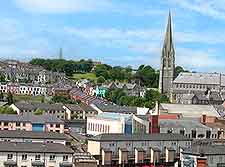
Derry is thought to have acquired its name from an Irish word, 'Daire'. It means an 'oak grove that is surrounded by water or bog'. The settlement was perched on a small hill, on an island that was surrounded by the waters of the River Foyle.
Derry has a long and rich history. Indeed, it has been continuously inhabited for many thousands of years. However, the earliest records of a settlement here date from the 6th century AD, with the foundation of a monastery. Legend has it that the monastery was created by St. Colmcille, a prominent Irish spiritual leader also known as St. Columba.
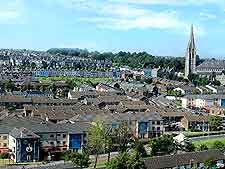
From Medieval Times to History of the 17th Century
In the Middle Ages, Derry enjoyed a measure of prosperity. It had largely escaped the worst ravages of marauding Vikings.
During the 12th and 13th centuries, the town was under the leadership of the Mac Lochlainns, who encouraged economic growth and building work, and gave patronage to Derry's school and monastery.
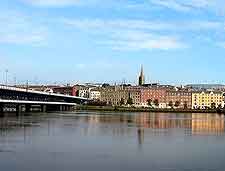
The English came to Derry in the latter part of the 16th century. They established a garrison here for a brief period in an attempt to control the province of Ulster, which still fell outside of Crown control. In 1600, they returned, choosing this time to stay on and establish a trading centre.
In 1604, Derry was granted city status. The early 17th century was something of a troubled time for the town. In 1608, it was attacked by Sir Cahir O'Doherty, which resulted in most of the city being laid waste. O'Doherty had previously supported the English in Ulster.
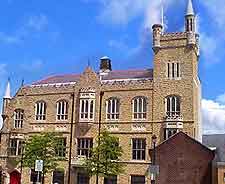
King James I of England decided that one way to subordinate Ulster was to bring in a population of English and Scottish migrants. The city of Derry was given to those who came from London; thus, it became known as Londonderry. Defensive stone walls were built between 1613 and 1618. Originally, there were four gates into the city - Bishop's Gate, Ferryquay Gate, Butcher Gate and Shipquay Gate. Later, three more gates were added. Today, they are the only ancient walls in Ireland to survive in such a complete state. New buildings were also added, including St. Columb's Cathedral.
In 1649, Derry was to suffer once again at the hands of military forces. The city, which was loyal to Cromwell's Parliamentarians, was besieged by Royalist forces. Then, in 1689, Derry endured a siege that was to last for over a hundred days and this event remains very much remembered in Irish history. Both the besieging Jacobites and those trapped inside the city suffered a great deal. Eventually, a relief ship arrived and the siege was ended.
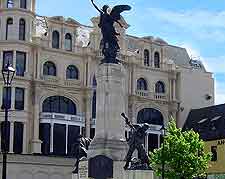
From the 18th Century to the Present
In the 18th century, Derry was largely rebuilt in the Georgian style. Indeed, many of the houses built at this time still survive. A bridge was built across the River Foyle in 1790. From the 18th to the 19th centuries, many of the inhabitants chose to leave the city in search of better lives. Those who embarked were headed for America; later, they founded the US state of
New Hampshire.
By the mid-1800s, Derry had grown into a fine industrial city. Most of its manufacturing activities were centred around shirt and collar making. Industrialisation was spurred on by the arrival of the railways - in all, there were four rail networks that led out of the city.
With the partition of Ireland in 1921, Derry acquired a new role, that of a border city. It was to later become known all over the world because of the 'Troubles'. This was a period of sectarian conflict that included the Battle of the Bogside in 1969, and the Bloody Sunday incident that took place here in 1972. In more recent years, a museum has been opened which focuses on this important period in Irish history.
 Derry is thought to have acquired its name from an Irish word, 'Daire'. It means an 'oak grove that is surrounded by water or bog'. The settlement was perched on a small hill, on an island that was surrounded by the waters of the River Foyle.
Derry is thought to have acquired its name from an Irish word, 'Daire'. It means an 'oak grove that is surrounded by water or bog'. The settlement was perched on a small hill, on an island that was surrounded by the waters of the River Foyle.
 The English came to Derry in the latter part of the 16th century. They established a garrison here for a brief period in an attempt to control the province of Ulster, which still fell outside of Crown control. In 1600, they returned, choosing this time to stay on and establish a trading centre.
The English came to Derry in the latter part of the 16th century. They established a garrison here for a brief period in an attempt to control the province of Ulster, which still fell outside of Crown control. In 1600, they returned, choosing this time to stay on and establish a trading centre. King James I of England decided that one way to subordinate Ulster was to bring in a population of English and Scottish migrants. The city of Derry was given to those who came from London; thus, it became known as Londonderry. Defensive stone walls were built between 1613 and 1618. Originally, there were four gates into the city - Bishop's Gate, Ferryquay Gate, Butcher Gate and Shipquay Gate. Later, three more gates were added. Today, they are the only ancient walls in Ireland to survive in such a complete state. New buildings were also added, including St. Columb's Cathedral.
King James I of England decided that one way to subordinate Ulster was to bring in a population of English and Scottish migrants. The city of Derry was given to those who came from London; thus, it became known as Londonderry. Defensive stone walls were built between 1613 and 1618. Originally, there were four gates into the city - Bishop's Gate, Ferryquay Gate, Butcher Gate and Shipquay Gate. Later, three more gates were added. Today, they are the only ancient walls in Ireland to survive in such a complete state. New buildings were also added, including St. Columb's Cathedral.